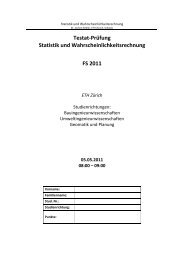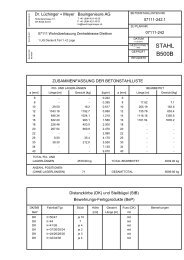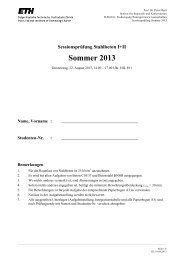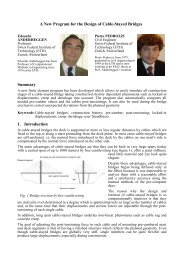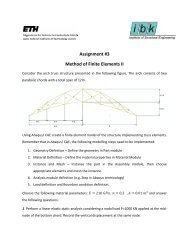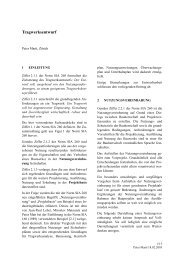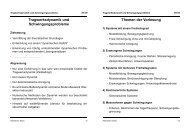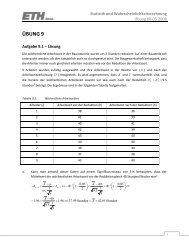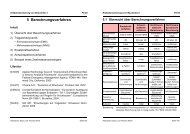Exercise 3.4 (Group exercise) - Solution
Exercise 3.4 (Group exercise) - Solution
Exercise 3.4 (Group exercise) - Solution
You also want an ePaper? Increase the reach of your titles
YUMPU automatically turns print PDFs into web optimized ePapers that Google loves.
<strong>Exercise</strong> <strong>3.4</strong> (<strong>Group</strong> <strong>exercise</strong>) - <strong>Solution</strong><br />
a. In order to plot the Tukey box plot five main features are required as shown in Table C.8 in<br />
the lecture notes. These are:<br />
• the lower quartile<br />
• the lower adjacent value<br />
• the median<br />
• the upper adjacent value<br />
• the upper quartile<br />
Consider the data of resistivity in direction 1. Based on Equation C.10 from the lecture notes a<br />
value ν is required such that<br />
ν = nQ + Q<br />
v<br />
v<br />
Therefore for the lower quartile (i.e. the 0.25 quartile) it is:<br />
ν = 25⋅ 0.25 + 0.25 = 6.5<br />
ν has a non integer value. The value is splitted to its integer part k = 6 and the fractional part<br />
p = 0.5<br />
Therefore the lower quartile is calculated as:<br />
x = (1 − p) x + px +<br />
= (1 −0.5) ⋅ 24.7 + 0.5⋅ 25.3 = 25 kOhm<br />
o o o<br />
v<br />
6 6 1<br />
In the same way for the upper quartile (the 0.75 quantile) it is:<br />
ν = 25⋅ 0.75 + 0.75 = 19.5<br />
ν has a non integer value. The value is splitted to its integer part k = 19 and the fractional<br />
part p = 0.5 .<br />
Therefore the upper quartile is calculated as:<br />
x = (1 − p) x + px +<br />
= (1 −0.5) ⋅ 28.3 + 0.5⋅ 28.7 = 28.5 kOhm<br />
o o o<br />
v<br />
19 19 1<br />
In order to calculate the median it is:<br />
ν = 25⋅ 0.5 + 0.5 = 13<br />
The 13th value of the data set is equal to 26.9 kOhm.<br />
To evaluate the adjacent values the interquartile range is required:<br />
r = Q0.75 − Q0.25 = 28.5 − 25 = 3.5<br />
The lower adjacent value is the smallest observation that is greater than or equal to the lower<br />
quartile minus 1.5r. It is:<br />
Q0.25 − 1.5r<br />
= 25 −1.5⋅ 3.5 = 19.75 kOhm
Thus from Table 3.1.1 the lower adjacent value is 20.2 kOhm.<br />
In the same way the upper adjacent value is found as:<br />
Q0.75 + 1.5r<br />
= 28.5 + 1.5⋅ 3.5 = 33.75 kOhm<br />
Therefore from Table <strong>3.4</strong>.1 the upper adjacent value is a value less than or equal to 33.75<br />
kOhm, that is 29.9 kOhm. Table <strong>3.4</strong>.2 summarizes the above features of both data sets.<br />
Direction 1 Direction 2<br />
Lower adjacent value 20.2 3.8<br />
Lower Quartile 25.0 8.65<br />
Median 26.9 11.1<br />
Upper Quartile 28.5 14.2<br />
Upper adjacent value 29.9 17.8<br />
Outside values - 2<strong>3.4</strong><br />
Table <strong>3.4</strong>.2: Descriptive statistics.<br />
The Tukey box plots are shown in Figure <strong>3.4</strong>.1.<br />
Figure <strong>3.4</strong>.1: Tukey box plot for direction 1 and 2.<br />
b. Both are left skewed, although the data of direction 2 are less skewed.<br />
c. It is proposed that the number of intervals k is: k = 1+ 3.3⋅ log( n)<br />
, where n is the number<br />
of data. By substituting n = 25 , k is obtained as: k = 1+ 3.3⋅log(25) ≈ 6 . From the histogram<br />
in Figure <strong>3.4</strong>.2, it is seen that the distribution is skewed to the left.
Figure <strong>3.4</strong>.2:<br />
Histogram.





